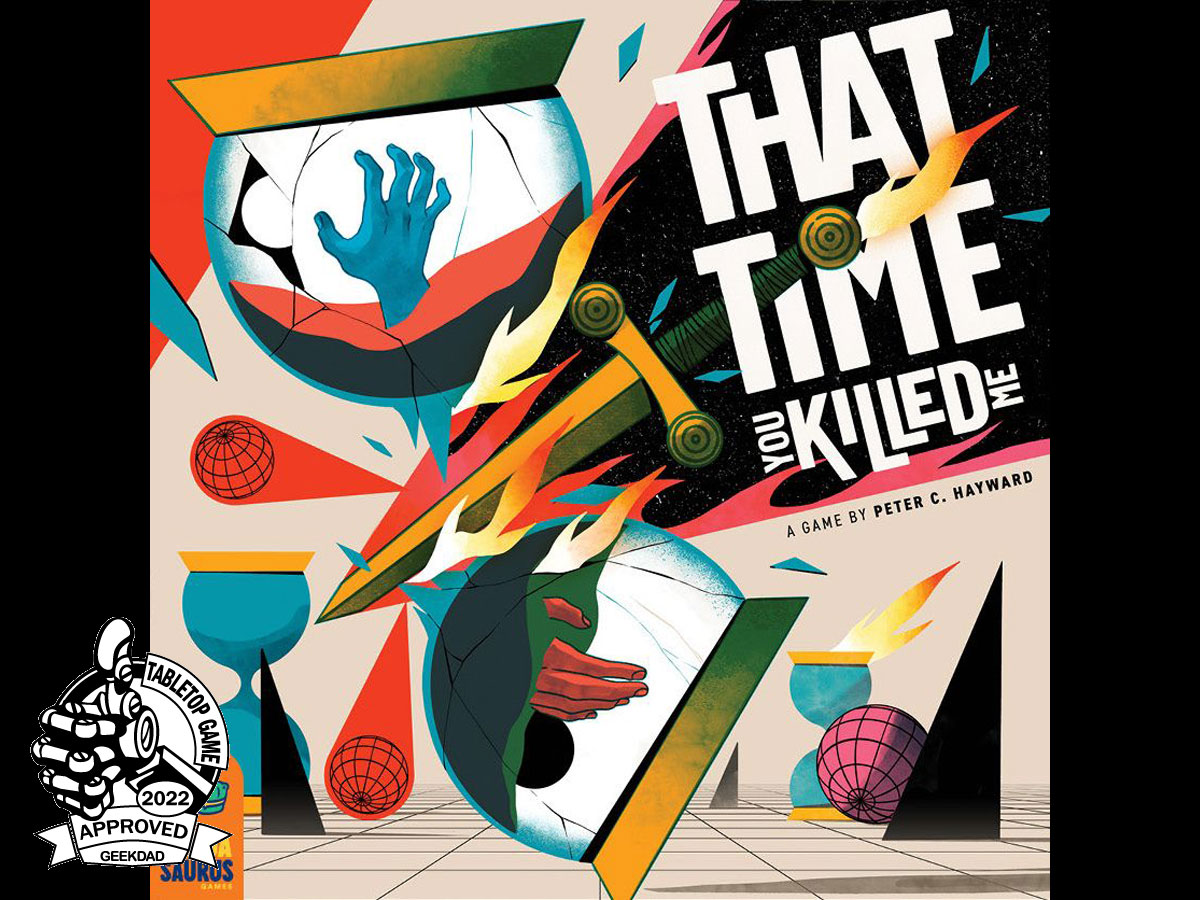You will invent time travel! Or perhaps you’ll murder the inventor and then go back in time to claim you invented it? I guess we’ll find out soon.
What Is That Time You Killed Me?
That Time You Killed Me is an abstract strategy game for 2 players, ages 10 and up, and takes about 15 to 30 minutes to play. It retails for $49.95 and is available in stores or directly from the publisher. The game itself has some chess-like mechanics, so I think you can play with kids, but just as with chess, some kids will be better than others at planning out moves. The setting involves time travel and murder, so if you choose to read the story portions of the cards you may want to preview them before sharing them with younger kids.
That Time You Killed Me was designed by Peter C. Hayward and published by Pandasaurus Games, with illustrations by Jor Ros.
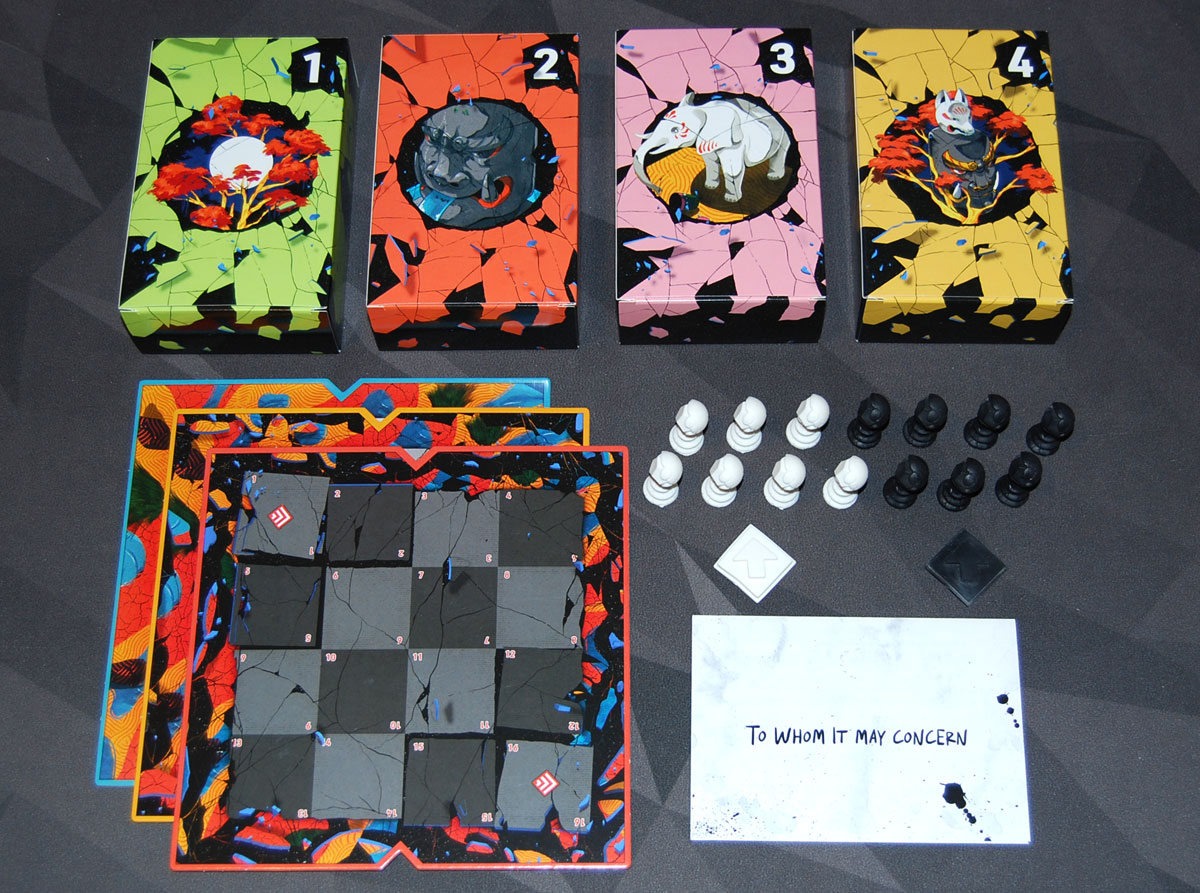
That Time You Killed Me Components
A lot of the components for That Time You Killed Me come in the four tuckboxes, which are to be opened as you play through the game, and they’re meant to be a surprise, so I don’t want to reveal too much. My review will show some of the components from the first box, since you open that one immediately, but I won’t reveal too much about the others yet.
Here’s what you can see when you first open the box:
- 4 tuckboxes
- 3 Era boards
- 14 pawns (7 each in black and white)
- 2 Focus tokens (1 each in black and white)
- A mysterious letter
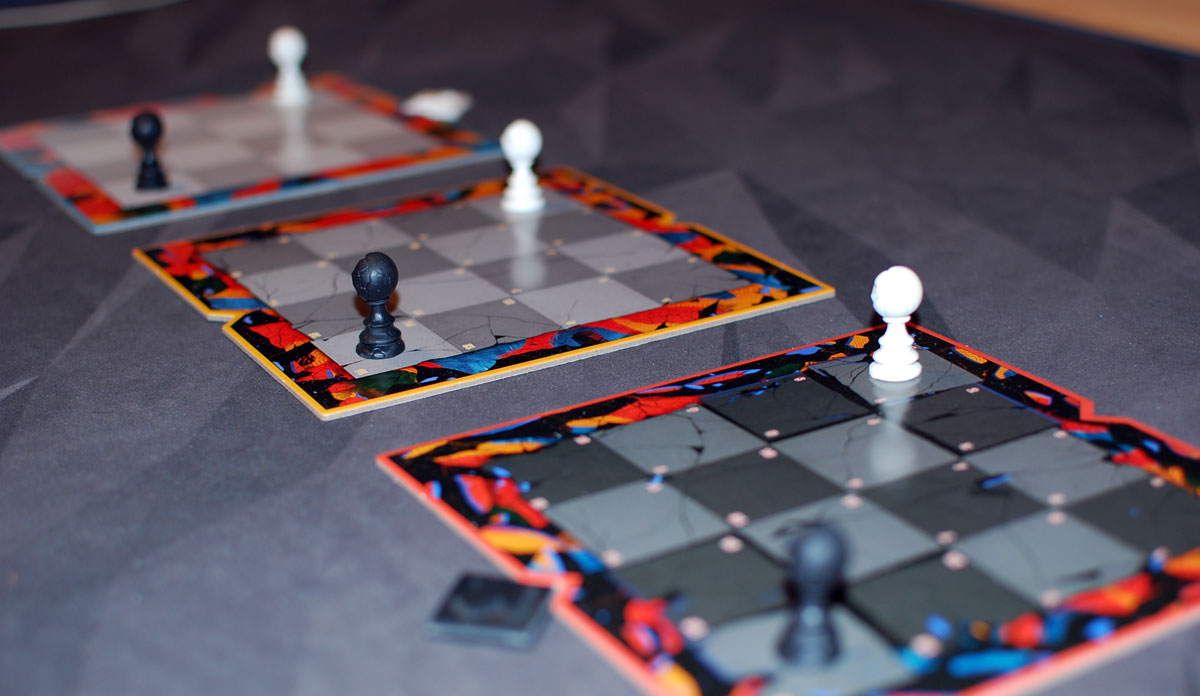
The era boards are each a 4×4 checkered grid, representing the past, present, and future, with numbered spaces to make it easy to find the same space from one board to the next. Each has a little notch on the top and bottom for the focus tokens. The artwork shows the board falling into disrepair: the past looks pristine, the present has a lot of cracks on it, and the future actually has the squares of the grid starting to separate and drift apart.
The pawns look a bit like chess pawns—a globe on top of a stand—except that the sphere has cracked open, revealing part of a dodecahedron inside. This motif of things breaking apart carries over into the artwork on the box cover and the tuckboxes as well, and I found Jor Ros’ illustrations bold and striking.
The letter, while not necessary to understand the gameplay, sets the scene and provides the story of the game: one of you will invent time travel, and the other one will go back in time to murder the inventor and steal the invention. Playing the game is replaying the events of the two of you trying to outwit each other in time, eventually figuring out who’s the actual inventor and who’s the murderous fraud. In the rulebook and in each of the tuckboxes, there are more messages from this unnamed character, always adding flavor but not strictly necessary for the rules. They’re printed in an uneven handwriting font, so it’s easy to separate out the rules from the flavor. (But I recommend reading them because they’re very funny!)
As for what’s in the boxes: there are more cards and more pieces, and you’ll see a few of them in the photos below. They are a lot of fun, but I enjoyed having them be a surprise so I won’t show you beyond the first box. The rulebook also has several points that tell you to stop so you don’t read ahead.
How to Play That Time You Killed Me
You can download a copy of the rulebook here.
The Goal
The goal of the game is to eliminate your opponent from at least 2 of the 3 eras.

Setup
The basic setup is usually the same: set up the three era boards in order. One player places white pawns on space “1” of each board, and the other player places black pawns on space “16” of each board. The white focus token starts in the past, and the black focus token starts in the future. The rest of the pawns are kept to the side as a supply.

Each chapter may have its own additional rules for setup, as well as additional actions that can be taken; these are explained in detail in the rulebook, but the cards give a summarized version (as well as an additional letter from the mysterious character).
Gameplay
On your turn, you choose a copy of yourself to activate, take 2 actions, and then shift focus.
Your focus token indicates what era you’re paying attention to, and you must choose a pawn in that era to activate. If there aren’t any, then you forfeit your actions for that turn, and simply shift focus.
You then take 2 actions with the chosen pawn—and you must take 2 actions if possible.
Standard actions include:
- Move 1 space orthogonally. If you move into an opponent’s pawn, you push it one space. If there’s a wall or immovable obstacle on the other side, the opponent is squished and is removed from the game (not returned to the supply). If a pawn is ever pushed or moved into another pawn of its own color, it creates a paradox and both pawns are removed.
- Travel forward in time: move your pawn to the same space in the next era. The space must not be occupied.
- Travel backward in time: move your pawn to the same (unoccupied) space in the previous era, and then place a new copy of yourself in the space you just left. If you have no more pawns in your supply, you cannot travel backward. (Note that the active copy is the one that moved to the past, so any additional actions will affect it, not the newly created copy.)
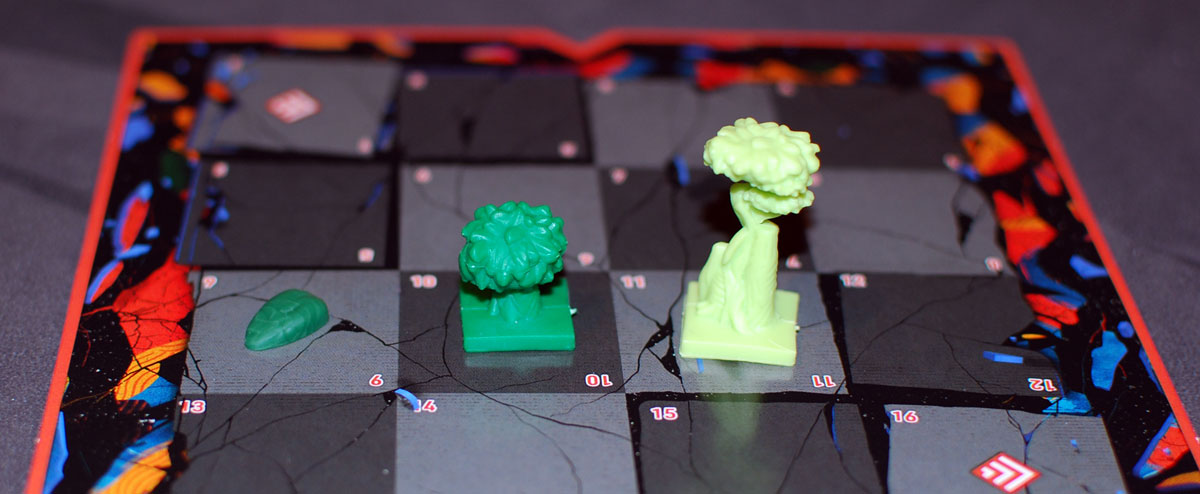
Each chapter will have its own additional rules. For the first chapter, Growth, you get some additional components: seeds, shrubs, and trees. You can use an action to plant a seed, which then places a shrub in the next era, and then a tree in the next era—as long as the spaces are currently empty.
Seeds aren’t obstacles and you can walk through them, and you can also use an action to remove a seed, which then removes the corresponding shrub and tree from future eras. Shrubs are immovable objects, so if you push somebody into a shrub, they get squished.
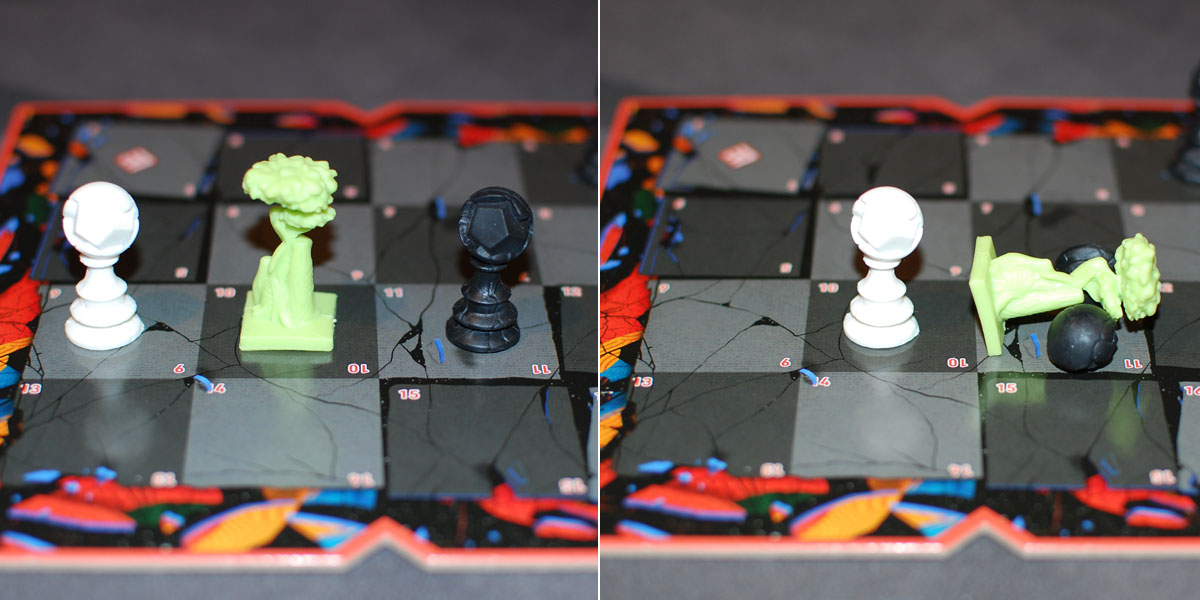
Trees can be pushed, toppling over (and then becoming immovable obstacles). If there’s a pawn on the other side of the tree, it gets squished.
Game End
If, at the end of your turn, your opponent is present in only one era (or none), then you have won! (Note that if you are reduced to one era in your turn, you haven’t lost yet, but it’s not a good position to be in.)
Additional Chapters
The rulebook recommends that you play at least 3 games of a chapter before continuing to the next chapter, at which point you can open the next tuckbox and read that section of the rulebook. (One important note that I missed: when you begin Chapter 2, you put away Chapter 1 and only use the components from Chapter 2.)
That Time You Killed Me is GeekDad Approved!
Why You Should Play That Time You Killed Me
If you also read my Stack Overflow columns about books, you know that I’m a fan of time travel stories. (I even co-hosted a podcast about time travel, though we’ve since retired it.) So I’m always interested to try games about time travel, to see both how the story is handled and how the time travel is translated into game mechanics.
That Time You Killed Me has a lot of clever things going on: the way that changes you make propagate across time (like the seed growing into a tree) allow for some clever moves and think-outside-the-box tactics. I particularly appreciated the way that traveling backward and forward in time work differently: if you go backward, then it adds a copy of you in the time you left because as time passes eventually you’ll find yourself back in that era again. But traveling forward doesn’t leave a copy behind, because you left and time moves in one direction. (Granted, traveling backward from the present to the past doesn’t create a second copy in the future, but games have to be simplified somewhere.)
The mechanics do use what we (in our podcast) called the “variable thread” version of time travel, where your actions in the past ripple forward and can change the present and future. That makes sense for the game, even if there are some problems and inconsistencies that can arise, and I’m okay with some of the hand-wavy explanations if it makes for a fun story.
And, oh, the story! The story in That Time You Killed Me is really entertaining, even though you get a limited window into this world. As I mentioned in the components section, the story bits—found in the rulebook, the letter, and some of the cards—aren’t strictly necessary to play the game, and you could certainly learn the game’s rules and play it without reading any of the slightly unhinged claims that this unnamed voice makes. However, that would be a big mistake. It’s very funny, and it takes what could appear to be a dry abstract strategy game and turns it into a vibrant whodunnit. You’re not just pushing pieces around on a board—you’re fighting for your very life! (Not to mention bragging rights for inventing time travel.)
What’s funny about this setup is that winning the game means you successfully squished the other player… which makes you the fraud? It’s an odd outcome to say that the villain is the one who wins, but that’s the sort of twisted humor you’ll find in this game.
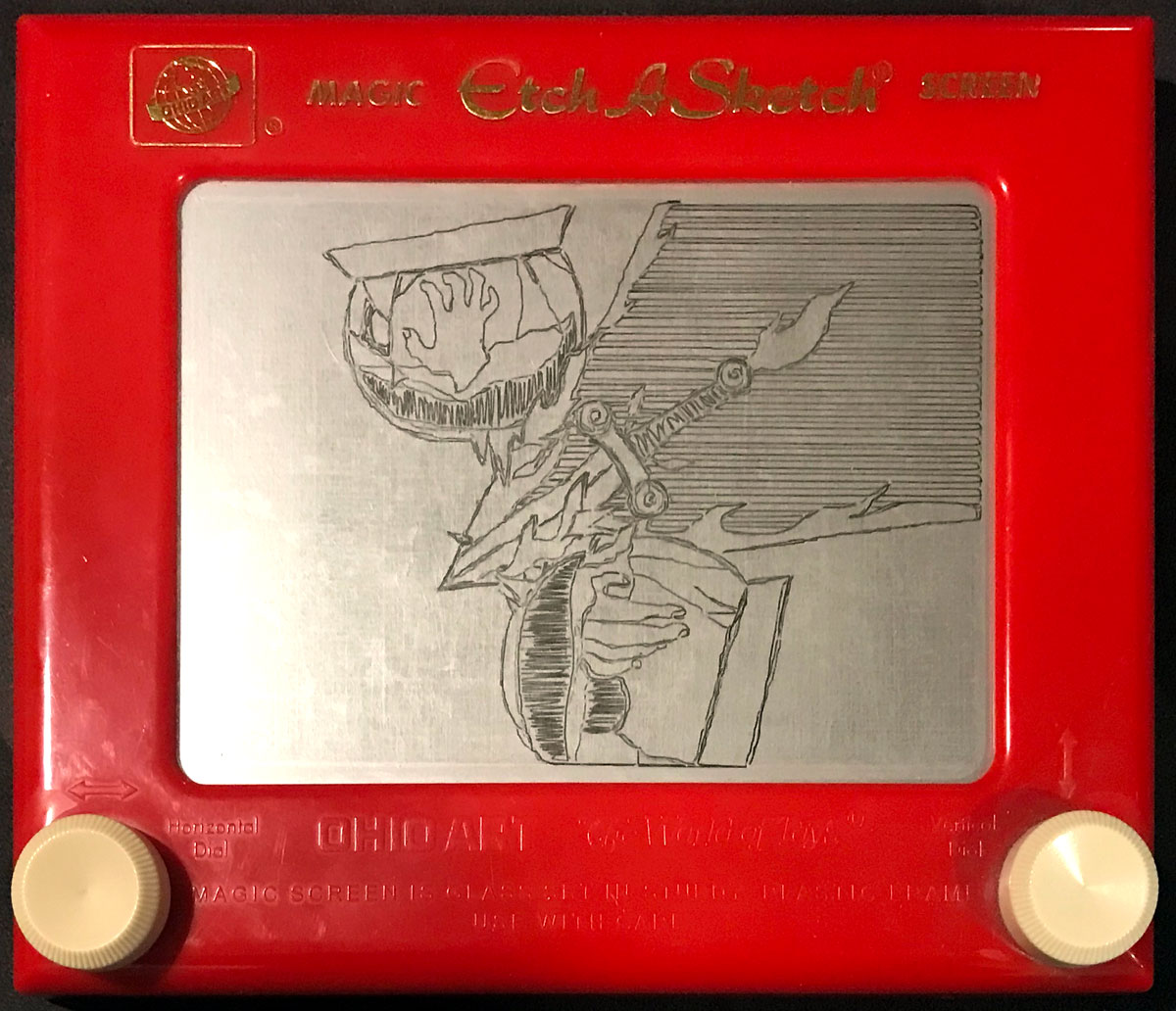
Without giving detailed spoilers about the other boxes, what I’ll say is that each one provides different ways to interact with things across time. The seed-shrub-plant system in Chapter 1 is the most straightforward and simple, but in later boxes, not everything stays put where you originally planted it. There are a lot of clever moves you can make—I know this because my opponent managed to sneak up on me in so many different ways.
You see, it turns out I’m not the best at That Time You Killed Me, which I guess means I’m most likely the real inventor of time travel. With only two actions per turn, it’s very hard to chase down another player and squish them against a wall just within a single era board. They can see you coming, and since the board is only a 4×4 grid, you can only get so close to somebody before you’re vulnerable to being squished yourself. (And once there are some shrubs or trees on the board, it gets even tighter.) Plus, you’re limited by where your focus is: you have to start in that era for your turn, and at the end of your turn you must move your focus to a different era. That can telegraph to your opponent what your plans may be—at the very least, they know which two eras you have less access to next turn.
So it takes those time travel actions to really be able to sneak up on somebody. You’re often maneuvering yourself in two different eras to get things to line up just so, whether it’s to plant a seed so that future you can knock down a tree or to hop to the past so you can make an extra copy of yourself in the present. Having extra copies, of course, sounds like it would be great—but just as we’ve learned from Calvin & Hobbes, sometimes it can just be a headache. On the one hand, making more copies of yourself gives you a chance to flank your opponent and pin them down. On the other, if you make yourself a crowd, it becomes easy for your opponent to shove you into yourself, taking out two copies in one action.
Although it may not seem like there’s going to be a lot of new content in just four boxes, there’s actually a lot to unlock, and it will take you a lot of plays before you see everything because of the way Chapter 4 is set up. I admit that I still haven’t seen all of it, in part because the friend I’d played this with the most moved away before we could unlock everything. I typically don’t play as many 2-player-only games because I typically have more than 2 players for game nights, but That Time You Killed Me was one that really stood out and had me wanting to play more. Each individual play was pretty quick (sometimes embarrassingly so), and it’s definitely a game that rewards repeated play. (We rushed ahead a little in progressing through the chapters so we could see a bit more of it before the move, so I definitely could use some more practice with the earlier chapters.)
I think That Time You Killed Me would work best for players who play head-to-head games frequently with the same opponent, both because you want to progress through the chapters at the same pace but also because of the way the Chapter 4 unlocks work. It may not work as well if the owner of the game is playing with lots of different opponents. I’m hoping to make time to play through this with a different challenger, and to take a little more time working through the different chapters the next time around! Good thing I’m going to invent time travel eventually.
For more information about That Time You Killed Me, visit the Pandasaurus Games website.
Click here to see all our tabletop game reviews.
![]() To subscribe to GeekDad’s tabletop gaming coverage, please copy this link and add it to your RSS reader.
To subscribe to GeekDad’s tabletop gaming coverage, please copy this link and add it to your RSS reader.
Disclosure: GeekDad received a copy of this game for review purposes.
